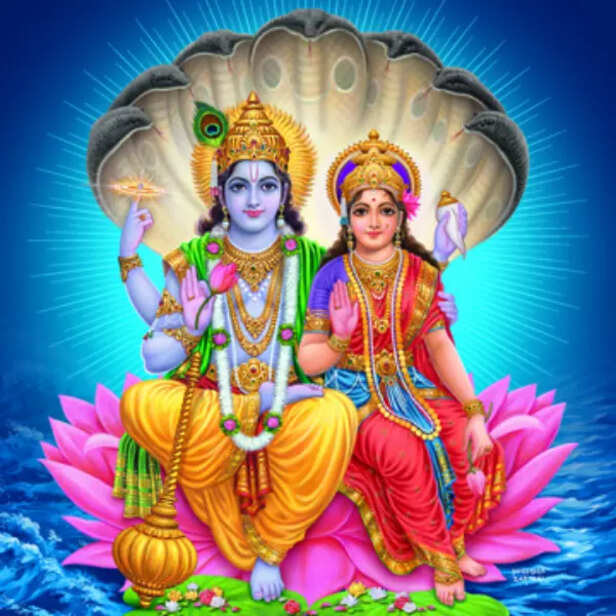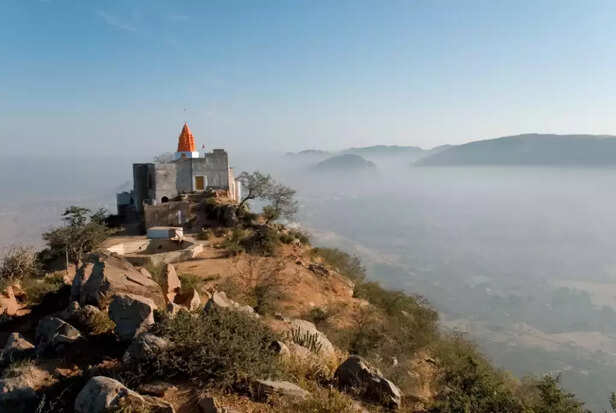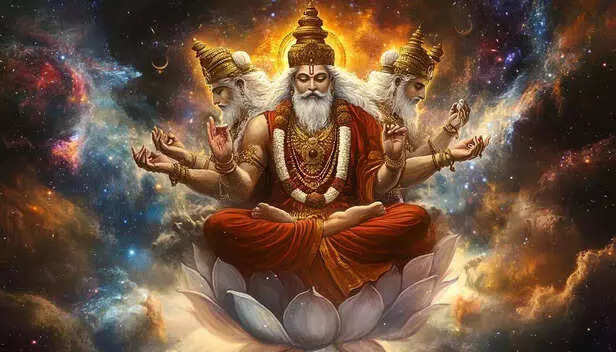Brahma’s Birth Story: The Spiritual Secret Hidden in Vishnu’s Nave
Nidhi | Feb 08, 2025, 20:19 IST
( Image credit : Freepik )
This article explores the fascinating story of how Brahma, the creator of the universe, emerged from a golden lotus sprouting from Vishnu’s navel. It delves into the deeper spiritual meaning of the cosmic ocean, the symbolism behind the golden lotus, and the life lessons hidden within this ancient tale. From understanding the five elements to Brahma’s search for purpose, this story offers valuable insights into the cycle of life, creation, and self-discovery.
What if the origin of the universe wasn’t a chaotic explosion but a serene, divine act of creation? Imagine an endless ocean, where time stands still, and at its center rests Lord Vishnu, the preserver of the cosmos. From his navel emerges a golden lotus, carrying Brahma, the creator of everything we know. This tale isn’t just mythology—it’s a journey into the mysteries of existence and a symbol of human potential.
Let’s explore the profound story of how Vishnu’s navel gave rise to Brahma and discover the deeper meaning hidden within this cosmic legend.

In the beginning, there was no earth, sky, or life—only the vast and tranquil Kshirsagar, the Ocean of Milk. It symbolizes the unmanifest energy that holds infinite possibilities, waiting to take form. Lord Vishnu, the preserver, lies on the coiled serpent Ananta Shesha, floating on this cosmic ocean. Vishnu’s calm, meditative state represents supreme consciousness and perfect harmony. The thousand-headed serpent signifies eternity and time’s cyclic nature. This ocean is more than a setting—it embodies the potential from which the universe is born, much like the potential within each of us before we shape our destinies.
From Vishnu’s navel emerges a radiant golden lotus, signifying purity, perfection, and the birth of life. This lotus is no ordinary flower—it holds Brahma, the god of creation. In spiritual traditions, the lotus represents beauty rising from muddy waters, untouched by its surroundings. It serves as a reminder that the most beautiful creations often arise from difficult circumstances. Just like the golden lotus blooms from Vishnu’s navel, human creativity and strength can emerge from challenging situations. The lotus here symbolizes the cycle of creation and spiritual awakening, urging us to rise above worldly chaos and reach our higher purpose.

When Brahma awakens on the golden lotus, he finds himself surrounded by an endless void—silent and vast. Confused and unsure of his role, he begins to meditate deeply, seeking guidance. Brahma’s quest for purpose is deeply relatable. It mirrors our human journey of finding meaning amid uncertainty. During his meditation, Brahma hears Vishnu’s divine voice instructing him to create the universe. This act of meditation before creation highlights an important life lesson: clarity and purpose often arise from stillness and introspection. Brahma’s meditation brings the elements of nature into existence, forming the foundation for life.
Brahma’s first task is to create the five elements—earth, water, fire, air, and ether—each playing a vital role in shaping the universe. Earth represents stability and foundation, while water symbolizes emotion and flow. Fire brings energy and transformation, air signifies movement and life force, and ether connects everything as the medium of space. These elements are not only cosmic forces but also exist within us, influencing our physical, emotional, and spiritual states. This creation marks the beginning of form and structure in the vast emptiness of the cosmos, showing that every creation requires fundamental building blocks.

After creating the five elements, Brahma organizes the universe into three distinct realms: Swarga (Heaven), Bhumi (Earth), and Patala (Underworld). Each realm serves a specific purpose in the grand design of existence. Swarga is the realm of higher consciousness and divine beings, symbolizing spiritual awakening and enlightenment. Bhumi, the earthly realm, represents the physical world where humans experience life’s joys and challenges. Patala, often misunderstood as a dark place, is actually a realm of hidden knowledge and transformation, symbolizing the subconscious mind and the power of rebirth. Together, these realms depict the different dimensions we navigate in our physical and spiritual journeys.
The story of Brahma’s birth is incomplete without understanding the cosmic dance of creation, preservation, and transformation. This eternal cycle is personified by the divine trinity—Brahma, Vishnu, and Shiva. Brahma is the creator, bringing new life and possibilities into existence. Vishnu, the preserver, maintains balance and harmony in the universe, ensuring its continuity. Shiva, the transformer, represents change and destruction, clearing the path for renewal and growth. This cycle reflects life’s natural flow: beginnings, sustenance, and inevitable transformation. Embracing this cycle helps us cope with life’s changes and see endings as the beginning of something new.
The golden lotus isn’t just a symbol of cosmic creation—it’s a metaphor for personal growth and transformation. Like the lotus that blooms from the depths of Vishnu’s navel, human beings have the potential to rise from adversity and achieve great things. The lotus grows in muddy waters but remains unstained, representing our ability to remain pure and unaffected by external challenges. In yogic philosophy, the navel (Manipura Chakra) is the energy center of willpower, confidence, and transformation. When we activate this inner power, we can unlock our creativity, courage, and higher purpose, just like Brahma’s emergence symbolizes spiritual awakening.

The story of Vishnu’s navel and Brahma’s birth holds timeless wisdom, offering lessons that remain relevant in our lives today. First, it teaches us the power of meditation and introspection. Like Brahma, who found his purpose through deep reflection, we can also find clarity in moments of stillness. Second, it encourages us to embrace change as a natural part of life’s cycle. Creation, preservation, and transformation are not isolated events but interconnected phases of existence. Finally, it reminds us of the immense creative power within each of us, urging us to rise above challenges like the golden lotus and manifest our potential.
At its core, the story of Vishnu’s navel and the birth of Brahma reminds us of the immense power we carry within. The golden lotus, a symbol of infinite possibility, exists within all of us. Brahma’s journey from uncertainty to creation is our journey too.
Whenever life feels overwhelming, remember that you have the potential to create, transform, and thrive. The cosmic dance of creation isn’t just an ancient myth—it’s a reminder that the universe is within you, waiting to unfold.
Let’s explore the profound story of how Vishnu’s navel gave rise to Brahma and discover the deeper meaning hidden within this cosmic legend.
The Cosmic Ocean: The Womb of Infinite Possibilities

Lord Vishnu
( Image credit : Times Life Bureau )
In the beginning, there was no earth, sky, or life—only the vast and tranquil Kshirsagar, the Ocean of Milk. It symbolizes the unmanifest energy that holds infinite possibilities, waiting to take form. Lord Vishnu, the preserver, lies on the coiled serpent Ananta Shesha, floating on this cosmic ocean. Vishnu’s calm, meditative state represents supreme consciousness and perfect harmony. The thousand-headed serpent signifies eternity and time’s cyclic nature. This ocean is more than a setting—it embodies the potential from which the universe is born, much like the potential within each of us before we shape our destinies.
The Golden Lotus: Creation Blooming from the Divine
Brahma’s Search for Purpose: The Journey of Self-Discovery

Brahma Temple
( Image credit : Times Life Bureau )
When Brahma awakens on the golden lotus, he finds himself surrounded by an endless void—silent and vast. Confused and unsure of his role, he begins to meditate deeply, seeking guidance. Brahma’s quest for purpose is deeply relatable. It mirrors our human journey of finding meaning amid uncertainty. During his meditation, Brahma hears Vishnu’s divine voice instructing him to create the universe. This act of meditation before creation highlights an important life lesson: clarity and purpose often arise from stillness and introspection. Brahma’s meditation brings the elements of nature into existence, forming the foundation for life.
Manifestation of the Five Elements: Building Blocks of the Universe
Brahma’s first task is to create the five elements—earth, water, fire, air, and ether—each playing a vital role in shaping the universe. Earth represents stability and foundation, while water symbolizes emotion and flow. Fire brings energy and transformation, air signifies movement and life force, and ether connects everything as the medium of space. These elements are not only cosmic forces but also exist within us, influencing our physical, emotional, and spiritual states. This creation marks the beginning of form and structure in the vast emptiness of the cosmos, showing that every creation requires fundamental building blocks.
The Three Realms: Mapping the Universe’s Dimensions

Brahma Ji
( Image credit : Freepik )
After creating the five elements, Brahma organizes the universe into three distinct realms: Swarga (Heaven), Bhumi (Earth), and Patala (Underworld). Each realm serves a specific purpose in the grand design of existence. Swarga is the realm of higher consciousness and divine beings, symbolizing spiritual awakening and enlightenment. Bhumi, the earthly realm, represents the physical world where humans experience life’s joys and challenges. Patala, often misunderstood as a dark place, is actually a realm of hidden knowledge and transformation, symbolizing the subconscious mind and the power of rebirth. Together, these realms depict the different dimensions we navigate in our physical and spiritual journeys.
Creation, Preservation, and Transformation: The Cycle of Life
The Lotus as a Guide to Personal Growth
Spiritual Wisdom from Vishnu’s Navel and Brahma’s Birth

Lord Brahma
( Image credit : Freepik )
The story of Vishnu’s navel and Brahma’s birth holds timeless wisdom, offering lessons that remain relevant in our lives today. First, it teaches us the power of meditation and introspection. Like Brahma, who found his purpose through deep reflection, we can also find clarity in moments of stillness. Second, it encourages us to embrace change as a natural part of life’s cycle. Creation, preservation, and transformation are not isolated events but interconnected phases of existence. Finally, it reminds us of the immense creative power within each of us, urging us to rise above challenges like the golden lotus and manifest our potential.
The Cosmic Truth: You Are the Creator of Your Own Universe
Whenever life feels overwhelming, remember that you have the potential to create, transform, and thrive. The cosmic dance of creation isn’t just an ancient myth—it’s a reminder that the universe is within you, waiting to unfold.
